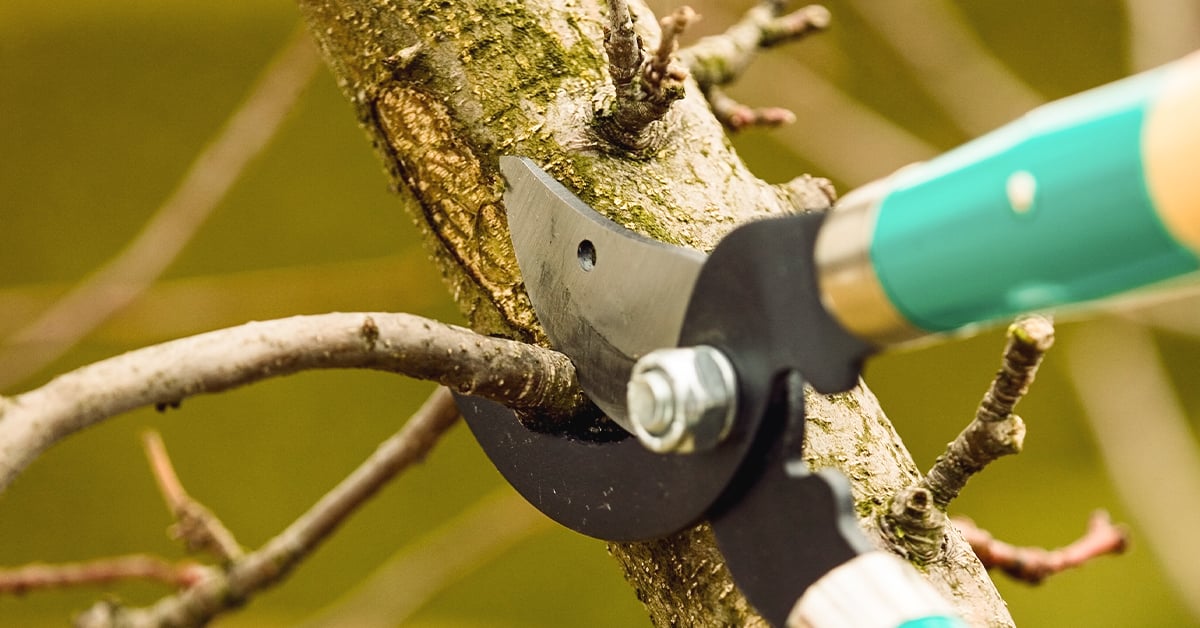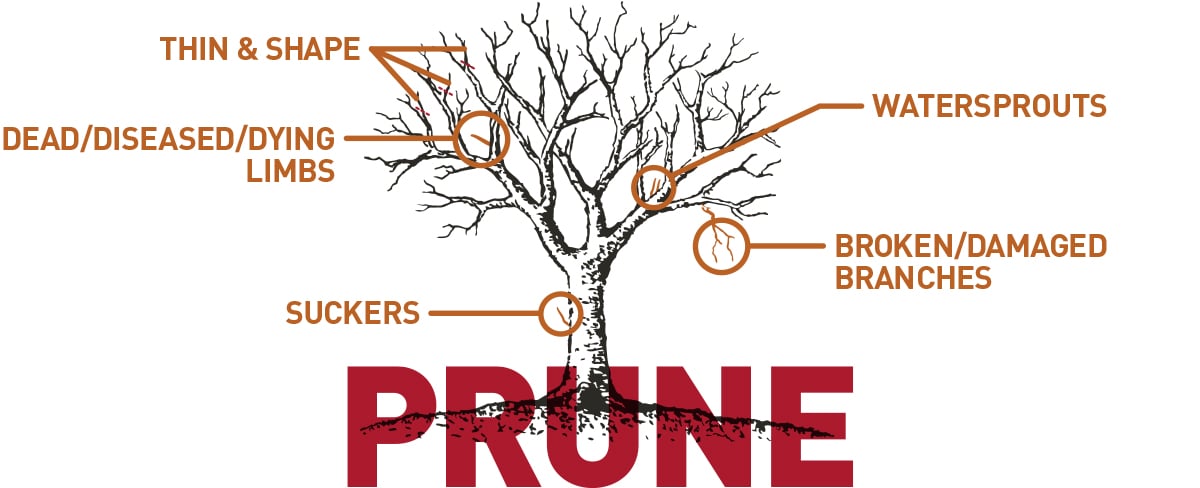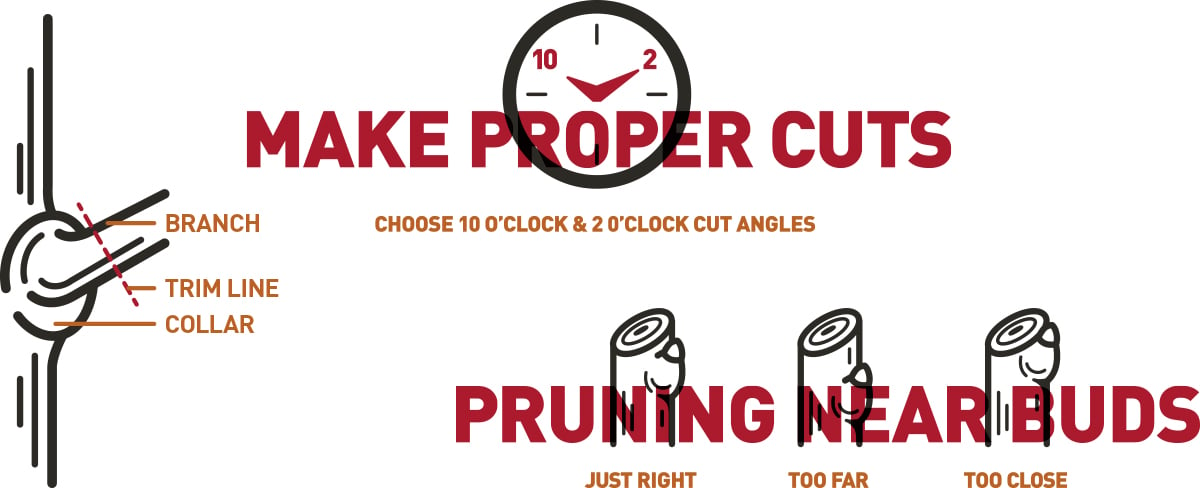
As melting snow gives way to warmer temperatures in the latter part of winter, it’s a prime time to consider pruning your trees.
The purpose of pruning is to remove wood that is unproductive or wounded in favor of wood that will produce fruit or contribute to the overall beauty and health of the tree. For those unsure of how to clip with confidence, here’s six helpful tips to remember when pruning your trees.
Why Pruning is Important for Healthy Trees
Effective pruning means having a healthier, stronger, balanced, safe and productive tree.
Following the winter months, prune to remove the three D’s — dead, diseased and dying tree limbs. In addition to enhancing the quality of the fruit and life of the tree, thinning the branches aids air flow, greater exposure to sunlight and prevents moisture from causing mold or fungus problems.

When Should You Prune Your Trees?
The ideal time to prune a tree is typically in February or March (Maybe earlier depending in your region and climate.), when the trees are dormant but temperatures are warming up. Of course occasions may arise when it’s necessary to cut a tree sooner, so go ahead and do it.
Pruning during the dormant period minimizes sap loss and subsequent stress to the tree. It also minimizes the risk of fungus infection or insect infestation. A neglected, older tree can be overgrown and difficult to prune. The most important cuts of shaping and forming a tree are made in the first five years of its life.
Steps to Take Before You Start Pruning
Before pruning, make sure you have the right tools and that they are in good condition. Sharp edges and blades make for clean, easy cuts that are significantly better for the tree.
Have a disinfectant solution ready before you start trimming. You need to disinfect all your tools after each tree with a disinfecting solution of 1 part bleach to 9 parts water, followed by soapy water and drying. Tree diseases spread much more easily when the tree is cut and its inner layers are exposed, just like we are more likely to get an infection when we have a cut. This means your cutting tools need to be thoroughly disinfected between each tree.
Another consideration before you make your first cut is how big the tree and/or job is going to be. The bigger the tree or job you have to do, the better it is to have someone to assist you in order to be safe and avoid serious injuries.
How to Prune Your Tree
When deciding how much to prune a tree, less is better. Each cut causes stress and increases its vulnerability to disease and insects. Plus, you can always prune more later but the tree can't regrow a branch you wish you'd kept.
Limit pruning to no more than 33 percent of the crown to ensure the living branches make-up at least two-thirds of the height of the tree. Excessive pruning can lead to reduced health and structural weakness of branches.
When cutting, prune at wide 10 o’clock and 2 o’clock angles:
1. Get Rid of "Suckers"
Start by removing the “suckers,” limbs growing directly upward from the base of the tree or main trunk, because they suck energy from the tree. Suckers are always weak branches. Leaving a few vertical limbs on the crown of younger trees, however, is a good way to encourage growth.
2. Prune Buds
When pruning to a bud, make sharp, clean cuts close enough that you don’t leave a clumsy stub, yet stay far enough above the bud so it won’t die. Prune back to buds aimed in the direction you want the limbs to grow.
3. Remove Branches
If you are trimming off a limb, you should cut as close to the other branch as possible so you don’t leave too much of a stub. However, make sure you don’t cut too close to the collar of the branch or trunk. Cutting into the collar will cause watersprouts and slow healing.
Once the suckers and inward growing limbs have been removed and the natural shape of the tree is more evident, look for places where limbs are crowded and crossing over each other. With fruit trees, the lower limbs can be eliminated so fruit isn’t growing close to the ground.
4. Trim Last to define the Tree's Shape
The final step to pruning a tree is to define the shape of the tree by cutting back the outermost limbs, which typically grow horizontally and curve upwards. By cutting these back to a downward facing bud, the branch will grow out rather than up.

Pruning Fruit Trees
Different types of fruit trees require different amounts of pruning. The general rule with apples, pears, plums, cherries, persimmons, peaches, apricots and plumcots is to remove 20 percent of the previous year’s growth. If your tree has not been pruned in several years, a more vigorous trim may be necessary. Even so, remember no more than one-third of the tree should be pruned.
On most fruit trees, try for an open vase shape, which leaves the center more open and spread out so fruit can ripen easier. It is also good to keep the tallest branches within reach so that it’s easier to pick fruit.
Post-Pruning Care
After pruning, give your trees a thorough watering to help them begin their recovery quickly. It’s also a good idea to fertilize the tree so it has extra energy to naturally close the pruning wounds and reduce stress on the tree. You should also be sure to properly dispose of all pruned wood, especially if it contains diseased material.
Start Cutting
Remember to go slow, be deliberate with each cut and step back from the tree between cuts to full assess the impact. And, if in doubt leave the branch alone; you can always come back later. A tree that has turned into a jumbled mess of branches can seem daunting, but these simple tips should give you the confidence you need to get started.
While pruning is an art that takes time to master, anyone can learn to be an expert. It takes a little patience and practice, but the impact pruning has on the health and look of your trees and shrubs make it well worth the time to learn.
For more information or questions about pruning trees, visit with our knowledgeable and experienced staff members your local IFA Country Store.
Information for this article was provided by Aaron Jaussi, Branch Manager, Provo IFA Country Store; Nick Loveland, Certified Arborist, Assistant Manager, Ogden IFA Country Store; and Kent Mickelsen, Utah Certified Nurseryman, IFA Country Store.








